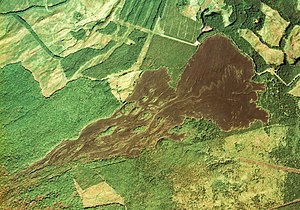Kīpuka

A kīpuka is an area of land surrounded by one or more younger lava flows. A kīpuka forms when lava flows on either side of a hill, ridge, or older lava dome as it moves downslope or spreads from its source. Older and more weathered than their surroundings, kīpukas often appear to be like islands within a sea of lava flows. They are often covered with soil and late ecological successional vegetation that provide visual contrast as well as habitat for animals in an otherwise inhospitable environment. In volcanic landscapes, kīpukas play an important role as biological reservoirs or refugia for plants and animals, from which the covered land can be recolonized.[1]
Etymology
Kīpuka, along with
Significance to research
Kīpuka provides useful study sites for
See also
- Puʻu Huluhulu – Volcanic cone in the Island of Hawaii
References
- ^ U.S. National Park Service. "Kīpuka - Hawai'i Volcanoes National Park". www.nps.gov. Retrieved 5 December 2021.
- ISBN 9780824829469.
- ISBN 9781478007418.
- ^ Hawaiian Language Dictionaries, Wehe²wiki². kīpuka.
- .
- S2CID 18812994. Retrieved 22 August 2013.
- S2CID 17911420. Retrieved 22 August 2013.
- S2CID 31190930.
External links
